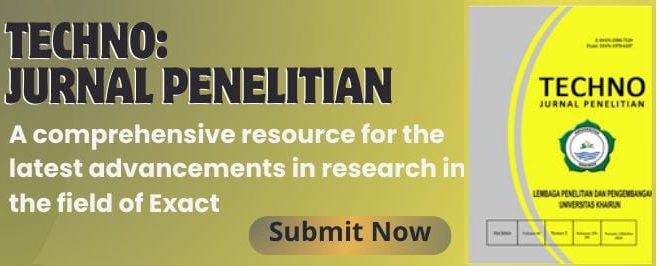Crystal Structure and Magnetic Susceptibility of Iron Sand From Pangeo Village, Morotai Jaya Subdistrict as The Cathode of Lithium-Ion Batteries
Abstract
Morotai Island has a wealth of iron sand which is a natural resource in Morotai Jaya District, Pangeo Village. The utilization of iron sand is still for local community building materials. The purpose of this study was to determine the structure and magnetic susceptibility of iron sand as a basic material for cathode materials in the manufacture of lithium-ion batteries (LIB). The research sample was taken randomly, then it was prepared in the laboratory to obtain dry-phase iron sand. After being tested using an XRD tool, namely samples A, E, and I, it was found that there was a lot of Fe3O4 contained in iron sand. The diffraction peaks indicate Fe3O4 material with an inverse spinel structure. Sample A is the most crystalline compared to sample I. Sample E has the lowest diffraction peak pattern due to the dominant mineral hematite (Fe2O3) 70.31%. The value of the BSM test obtained the greatest magnetic susceptibility of 82867.54x10-8m3 /kg. The smallest is in sample J with a value of 13186.98 54x10-8m3 /kg because during synthesis it is slightly attracted by magnets and the color is not too black which mixes a lot with other materials. In addition, this relationship is directly proportional to sample E which contains the magnetic material Fe2O3 of the characterization of 70.31. The range of magnetic susceptibility values in samples A to L is in the interval (46 – 80,000) x 10-8m3/kg, and (20,000 - 110,000) x 10-8m3/kg. Based on this interval, both magnetic and mass susceptibility of each iron sand sample contained ilmenite (FeTiO3) particles in the antiferromagnetic group and magnetite (Fe3O4) in the ferromagnetic group.
Keywords
Full Text:
PDFReferences
Afkhami, S., & Renardy, Y. (2017). Ferrofluids and Magnetically Guided Superparamagnetic Particles in Flows: A Review of Simulations And Modeling. Journal of Engineering Mathematics, 107(1), 231–251. https://doi.org/10.1007/s10665-017-9931-9
Ahsan, Z., Ding, B., Cai, Z., Wen, C., Yang, W., Ma, Y., & Zhang, S. (2021). Recent Progress in Capacity Enhancement of Lifepo4cathode for Li-Ion Batteries. Journal of Electrochemical Energy Conversion and Storage, 18(1). https://doi.org/10.1115/1.4047222
Haryati, E., Dahlan, K., Bunga, M., Napitupulu, D., & Togibasa, O. (2021). Mineral Content and Magnetic Properties of River Iron Sand from Jayapura, Papua. Journal of Magnetism and Its Applications, 1(2), 30–33. https://doi.org/10.53533/jma.v1i2.13
Khorsand Zak, A., Shirmahd, H., Mohammadi, S., & Banihashemian, S. M. (2020). Solvothermal Synthesis of Porous Fe3O4 Nanoparticles for Humidity Sensor Application. Materials Research Express, 7(2), 1–10. https://doi.org/10.1088/2053-1591/ab6e3c
Lamburu, A. A., Syafri, I., Yuningsih, E. T., and Utara, H. (2017). Karakteristik Mineralogi Endapan Pasir Besi di Daerah Galela Utara Kabupaten Halmahera Utara Provinsi Maluku Utara. Bulletin of Scientific Contribution, 15(2), 151–160. https://doi.org/10.24198/bsc%20geology.v15i2.13395
Malega, F., Indrayana, I. P. T., & Suharyadi, E. (2018). Synthesis and Characterization of The Microstructure and Functional Group Bond of FE3O4 Nanoparticles from Natural Iron Sand in Tobelo North Halmahera. Jurnal Ilmiah Pendidikan Fisika Al-Biruni, 7(2), 13-22. https://doi.org/10.24042/ jipfalbiruni.v7i2.2913
Paniyarasi, S. A. S., Suja, S. K., & Elizabeth, R. N. (2021). Doping and Surface Modification Enhance the Applicability of Nanostructured Fullerene–MWCNT Hybrid Draped LiNi0.1Mg0.1Co0.8O2 as High Efficient Cathode Material for Lithium-Ion Batteries. Journal of Inorganic and Organometallic Polymers and Materials, 31(10), 3976–3990. https://doi.org/10.1007/s10904-021-02039-5
Sadjab, B. A., Indrayana, I. P. T., Iwamony, S., & Umam, R. (2020). Investigation of The Distribution and Fe Content of Iron Sand at Wari Ino Beach Tobelo Using Resistivity Method with Werner-Schlumberger Configuration. Jurnal Ilmiah Pendidikan Fisika Al-Biruni, 9(1), 141–160. https://doi.org/10.24042/jipfalbiruni.v9i1.5394
Saputro, R. E., Taufiq, A., Hidayat, N., Sunaryono, Hariyanto, Y. A., & Hidayat, A. (2019). Preparation of Fe3O4/OA/DMSO Ferrofluids using a Double Surfactant System as Antifungal Materials Candidate. IOP Conference Series: Materials Science and Engineering, 515(1). https://doi.org/10.1088/1757-899X/515/1/012029
Sebayang, A. M. S., Rianna, M., Sagala, L. P. S., Asri, N. S., Tetuko, A. P., Setiadi, E. A., Nurdiyansah, L. F., Amiruddin, E., Sembiring, T., & Sebayang, P. (2022). Nano-structures and magnetic properties of Zn1-xCux/2Nix/2Fe2O4 (x = 0-0.4) synthesized from natural iron sand. South African Journal of Chemical Engineering, 42(August), 216–222. https://doi.org/10.1016/j.sajce.2022.08.013
Shen, F., & Liu, Y. (2021). LiFePO4 Cathode Material Modification and its Recycling Research Based on The Development Status of Lithium-Ion Batteries. Academic Journal of Environment & Earth Science, 3(3), 4–8. https://doi.org/10.25236/ajee.2021.030302
Steward, D., Mayyas, A., & Mann, M. (2019). Economics and Challenges of Li-Ion Battery Recycling from End-Of-Life Vehicles. Procedia Manufacturing, 33, 272–279. https://doi.org/10.1016/j.promfg.2019.04.033
Togibasa, O., Bijaksana, S., & Novala, G. C. (2018). Magnetic Properties of Iron Sand from The Tor River Estuary, Sarmi, Papua. Geosciences (Switzerland), 8(4). https://doi.org/10.3390/geosciences8040113
Wang, M., Liu, K., Yu, J., Zhang, C.-C., Zhang, Z., & Tan, Q. (2022). Recycling Spent Lithium-Ion Batteries Using A Mechanochemical Approach. Circular Economy, 1(2), 100012. https://doi.org/10.1016/j.cec.2022.100012
Yang, G., Pan, K., Lai, F., Wang, Z., Chu, Y., Yang, S., ... & Li, Q. (2021). Integrated Co-Modification of PO43− Polyanion Doping and Li2TiO3 Coating for Ni-Rich Layered Lini0. 6Co0. 2Mn0. 2O2 Cathode Material of Lithium-Ion Batteries. Chemical Engineering Journal, 421, 129964. https://doi.org/10.1016/j.cej.2021.129964
Sun, Y. Q., Luo, X. T., Zhu, Y. S., Liao, X. J., & Li, C. J. (2022). Li3PO4 electrolyte of high conductivity for all-solid-state lithium battery prepared by plasma spray. Journal of the European Ceramic Society, 42(10), 4239-4247. https://doi.org/10.1016/j.jeurceramsoc.2022.04.010
Yulianto, A., Bijaksana, S., & Loeksmanto, W. (2003). Comparative Study on Magnetic Characterization of Iron Sand from Several Locations in Central Java. Indonesian Journal of Physics, 14(2), 63–66.
Zhang, H., Zou, Z., Zhang, S., Liu, J., & Zhong, S. (2020). A review of the Doping Modification of LiFePO4 as a Cathode Material for Lithium Ion Batteries. International Journal of Electrochemical Science, 15, 12041–12067. https://doi.org/10.20964/2020.12.71
Zhou, Y., Chen, P., Chen, M., Li, J., Li, X., Lin, L., Lun, Y., Li, Q., Xiao, Q., Huang, Y., Wang, X., Zou, H., & Ye, G. (2022). γ-Fe2O3@Poly(sucrose allyl ether) Magnetic Microspheres for Tumor Enhanced Magnetic Resonance Imaging and High-Efficiency Cooperative Magnetothermal Therapy. Materials and Design, 222, 111062. https://doi.org/10.1016/j.matdes.2022.111062
DOI: https://doi.org/10.33387/tjp.v11i2.5562
Refbacks
- There are currently no refbacks.
Copyright (c) 2022 Suryani Taib

This work is licensed under a Creative Commons Attribution-NonCommercial 4.0 International License.
-------------------------------------------------------------------------------------------------------------------------------------------------------------------
-------------------------------------------------------------------------------------------------------------------------------------------------------------------
TECHNO: Jurnal Penelitian
Published by: LPPM Universitas Khairun
Addres : Jalan Yusuf Abdurrahman Kampus II Unkhair, Kelurahan Gambesi, 97722 Kecamatan Kota Ternate Selatan, Provinsi Maluku Utara, Email: techno@unkhair.ac.id | URL: http://ejournal.unkhair.ac.id/index.php/Techno
Techno Jurnal Penelitian is licensed under a Creative Commons Attribution-NonCommercial 4.0 International License.


























